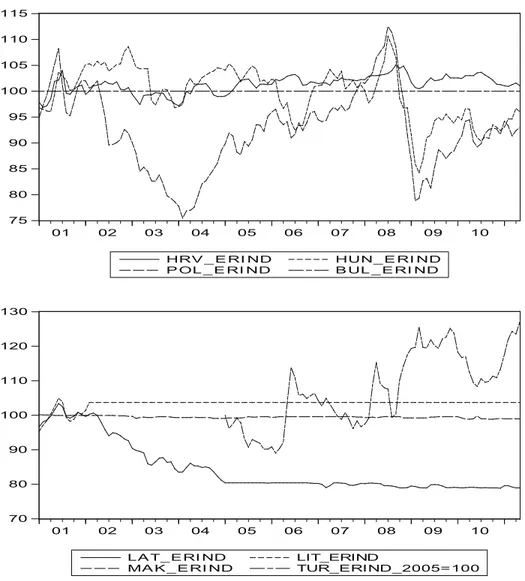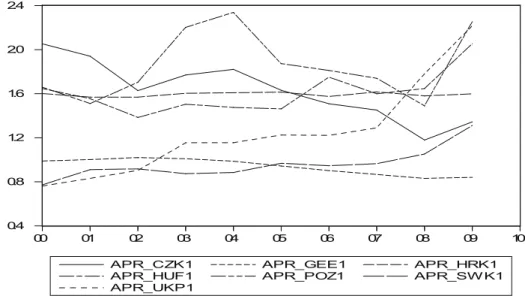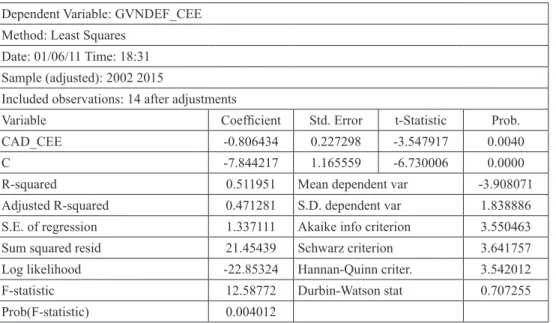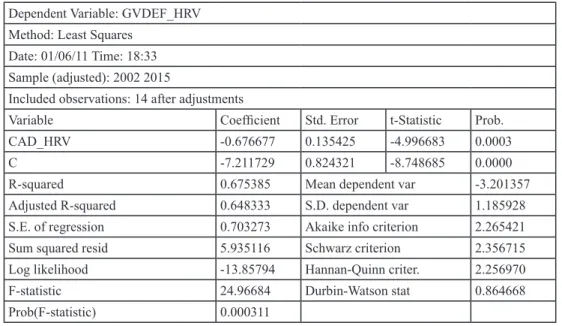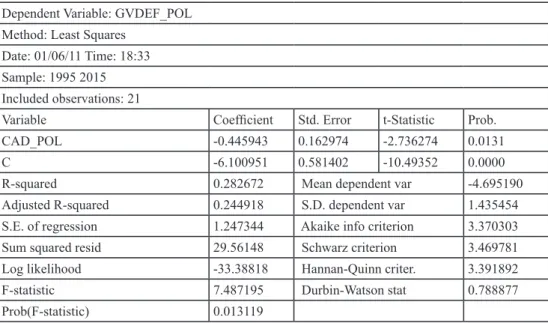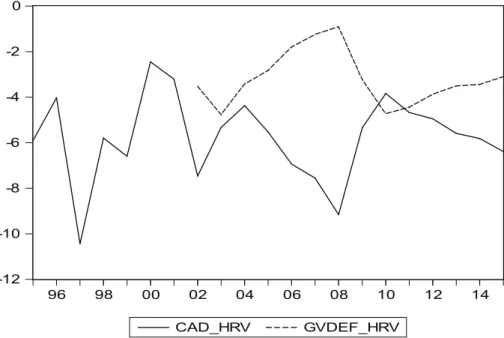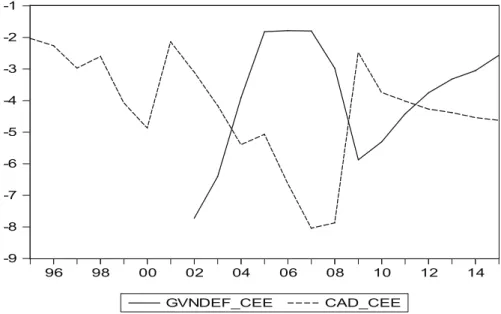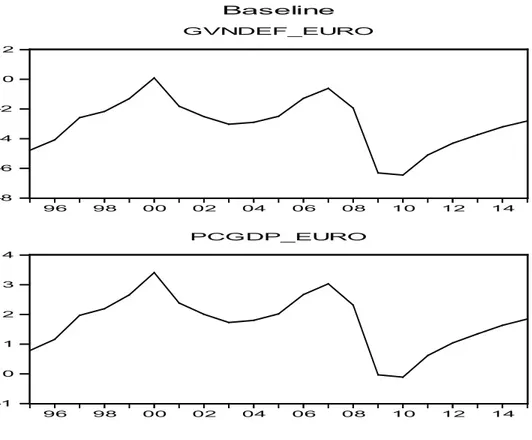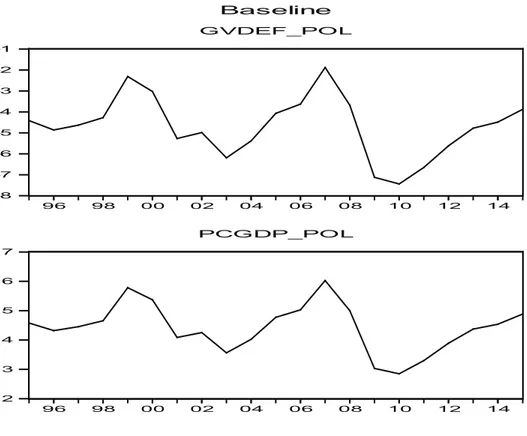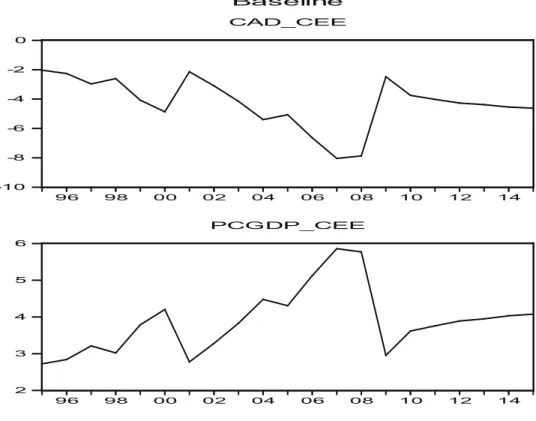Preliminary communication UDC 336.71/.77: 338.124.4
From the impossible monetary trinity towards
economic depression
*Stjepan Zdunić
1Abstract
The aim of the paper is to determine the interdependency of both balance of payments and fiscal deficit in the context of liberalized systems of capital flows with mainly stabile and appreciated exchange rate and their impact on the dynamics of growth of transition economies of Central and Eastern Europe with special retrospect to Croatia. In the research we used a classical econometric model for aggregated series of data of a group of transition countries, and individually for Croatia and Poland. We determine a significant regression interconnection between fiscal and balance of payments deficits for the group of transition countries, and individually for Croatia, with the exception of Poland and Eurozone. Furthermore, we explore the interdependency of these deficits with the growth rate of gross domestic product of analysed CEE countries and Croatia, where we obtain only partially significant regression results. The final conclusion of the analysis is the existence of significant inverse relationship of balance of payments and fiscal deficits of aggregates of transition economies and Croatia. Growth rates of gross domestic product loosely depend on the balance of payments deficit of groups of transition countries, which cannot be concluded for Croatia. In the case of relationship between the growth rate of gross domestic product with current budget deficits of the analyzed group of transition countries we do not obtain satisfactory significance. From the entire analysis we can conclude that the policy of reducing the balance of payments deficit with the secondary goal of reduction of budget deficit and a decrease in foreign debt, in present condition, has a pro-recessionary effect for the majority of transition countries.
Key words: twin deficit, monetary trinity, econometric model, fixed exchange rate, currency clause, liberalized financial market, depression
JEL classification: E52, F31, F32, H62
* Received: 15-09-2011; accepted: 29-11-2011
1 Scientific advisor (ret), Stjepana Ljubića Vojvode 12, 10000 Zagreb, Croatia. Scientific
affiliation: economic and development policy, monetary policy, international economic relations. Phone: + 385 1 383-29 35. E-mail: stjepan.zdunic1@zg.t-com.hr.
1. Introduction
Coming from the theoretical Mundell-Fleming model which links growth rate of gross domestic product (GDP) with the regime of exchange rate and the degree of capital flows liberalisation, in our conditions it is necessary to specifically examine the issue of limitations of monetary and fiscal policy as instruments of antirecessionary policy in conditions of fixed exchange rate. This is due to the fact that we have exogenously given both the exchange rate and current budget deficit, which we illustrate by a theoretical model in picture 1. That model logically depicts basic properties of present Croatian fiscal and monetary policy that operate in such given constraints that reduce their efficiency. The limitation of efficiency comes from the Maastricht criteria, liberalized capital account and monetary sovereignty of the country. We can term this phenomenon as the impossible monetary trinity. In such conditions the Croatian development strategy suffers too large constraints in order to successfully overcome long-term recession which transited into the state of depression of the Croatian economy in whole, for the long-term. In regards to that, starting hypothesis of the research is, first, fixed exchange rate regime and liberalized system of capital flows conditions non-sovereign monetary system which prevents an active anti-recessionary and development policy of the country; second, regression relationship between current account deficit of balance of payments with growth rate of GDP, on the other hand, has to show previous character and (im)possibility of monetary and fiscal policy in overcoming depression and attaining dynamic growth of transition economies of Eastern Europe and Croatia. Therefore, in the next part of the study we cover the following areas: (2) According to the Mundell-Fleming model, in present conditions, fiscal policy in stimulating growth is limited by the Maastricht criteria, (3) Monetary triangle and twin deficit, (4) Empirical and analytical test of thesis of monetary trinity and twin deficit of CEE countries with Turkey, including Croatia as well, (5) Is it possible to overcome the depression in current model of economic system of EURO zone and IMF?, (6) Concluding discussion on the results of the research, (7) Concluding remarks.
2. According to the Mundell-Fleming model, in present conditions,
fiscal policy in stimulating growth is limited by the Maastricht
criteria
This chapter provides a theoretical basis (Gartner, 2006) and is the starting point of our analysis, which assumes sufficient knowledge of real economic processes in the Croatian economy, particularly in regard to monetary and fiscal system and policy. Therefore, we do not bore the text with empirical data. In the next chapter, on the contrary, we empirically test the basic theoretical settings presented here, mainly by
using the appropriate chart of empirical data, then a regression analysis, for Croatia and the wider group of countries in transition.
Picture 1: Conditions of the increase of gross domestic product
Source: According to Gartner, 2006
The model thus highlights the increase in GDP, influenced by the growth of government spending in conditions of a fixed exchange rate, FE, and liberalized capital flows and interest rates. The theoretical implications of the fixed exchange rate and liberal capital flows, and built-in constraints, as derived from the analysis given in Picture 1, can be summarised as follows:
The increase in government expenditure shifts the IS curve to the right. This increases the GDP, which entails an increase in demand for money, which then increases the interest rate, i. The consequence is the further increase of attractiveness of government bonds and strengthening of foreign capital inflows, which again increases the demand for domestic currency. Since the central bank is obligated to meet the demand for domestic currency, which is required for the purchase of an increased supply of foreign currency, the LM curve also shifts to the right. At this point GDP0 raises to GDP1, but interest rates return to the equilibrium interest rate i0
as well. In this process the initial equilibrium point A transits to the final new equilibrium point B. However, in the circumstances of given fixed exchange rate regime and ratio of budget deficit in GDP, as well as in terms of the Maastricht criteria, the process falls into a sort of budget and fixed-exchange rate limitation, or trap. Theoretically speaking, this refers to the Croatian case. Therefore, we cannot fully unwind “circular flow” as described above, so that completion of this course is
an increase in GDP from GDP0 to GDP1. Due to given constraints, the new
equilibrium is established between points A and B, i.e. the “capacity” to increase government spending can not be fully exploited to increase GDP growth in a state of recession! Fixed exchange rate and the forwardly given too narrow (or zero!) budget deficit in relation to GDP limits the effect of depicted “circular flow” in terms of GDP growth. With underdeveloped institutional mechanisms in monetary and fiscal system to overcome these limitations, such process produces long-term recession, what is being observed nowadays in Croatia.
3. Monetary trinity and twin deficit
In this chapter, based on the previous analysis of the Mundell-Fleming model, we will first explain the schematic version of the monetary trinity where the sole objective of monetary policy is “stable” and fixed nominal exchange rate with fully liberalized capital movements. Such an objective of monetary policy and the regime of balance of payments capital account entails non-sovereign monetary system, which can not support national development goals such as full utilization of the economic potential and the country’s workforce. The degree of openness of foreign trade and capital flows in practical policy is quite different. We simplify, for analytical reasons, that these systems in our circumstances can be categorized as “liberalized”. Further on this basis we establish the existence of an inverse correlation of balance of payments current account deficit and current deficit of the general budget, or so called ‘‘twin deficits” (twin deficit, Eng.), i.e. when one increases the latter decreases (Zdunić, 2009:231). In other words, there should be a significant regression correlation, i.e. satisfactory significance of dependent variables with a negative coefficient for the explanatory variable. In doing so, the dependent variable is the state budget deficit, GVNDEF, expressed as a percentage of gross domestic product, GDP, and the explanatory variable is the current account deficit of balance of payments, CAD, expressed by a percentage of GDP. In specific models with these variables we add a label which denotes the country or countries to which the variables are related. All these issues are synthesised in Scheme 1.
Scheme 1: Monetary trinity in conditions of fixed exchange rate and open capital markets – non-sovereign monetary system
A. Fixed exchange rate
→
→
C. Non-sovereign monetary system
B. Open capital market
→
↓
The Mundell-Fleming model shows that due to the fixed exchange rate there is impossibility of monetary expansion with the goal of increase of the GDP growth rate and that capital market balances the national interest rate with the global interest rate;
↓
Since the ultimate goal of monetary policy is fixed exchange rate, in Croatian circumstances, and by the request set by the Maastricht criteria, the budget deficit is limited with the secondary goal of keeping interest rates at a given level. When it comes to the EMU countries, monetary expansion and, in such manner, limited fiscal expansion do not allow the so-called quantitative easing policy aimed at encouraging the growth rate of GDP;
↓
The foreign exchange clauses, in Croatian situation, increase the limiting role of fixed exchange rates, by making monetary expansion impossible. Contradictory, in the same time they increase the risk of the rise of interest rates on national credit and financial markets on the basis of the interest rate parity, and based on the exchange rate differences and risk premiums; then, exchange rate clauses bring more monetary systems in a single monetary area, breaking it, i.e. parcel monetary system of Kuna by other currencies like the euro, Swiss franc, U.S. dollar and the like, and it makes it chaotic;
↓
However, fixed stable and appreciated exchange rate in a liberalized foreign trade and the balance of payments system produces the persistent current account deficits of balance of payments, by substituting domestic supply with imports which results in growth of gross external debt, mainly generated by the private sector;
↓
Given that by the logic of the triangular proposition, or impossible trinity theorem, we have non-sovereign monetary system in Croatia, we can pose a question on the kind of mutual dependence of the balance of payments deficits and fiscal deficits. For this purpose, we examine the characteristics of the so-called dual deficit (twin deficits), which created the illusion of tolerable budget deficit. This tolerance is determined by the autonomous movement of the balance of payment deficit in relation to the budget deficit, which is predominantly associated with stable fixed rates, which due to increased free and competitive imports lowers the budget deficit, i.e. increases the budget revenues. Thus, the fixed exchange rate and tolerable budget deficit, based on the free import of goods, to which domestic production could not compete, is the fundamental and long-term causal factor in depression of Croatia and other countries as well.
Further specificities of the exchange rate regimes in relation to the policy of increasing rates of GDP growth can be summarized as follows:
1) The low of the monetary triangle connects the points A, B and C in the previous Scheme 1 into a single geometric figure, i.e., a triangle, which shows that in the same direction there can lie only two vertices of the triangle. Stated by economic terms, this means that only two of the three monetary objectives can be mutually consistently achievable. Economic policy must, therefore, decide which one will be rejected. If monetary policy desires to achieve the goal of C, according to our scheme that is monetary sovereignty, which is used to achieve higher growth rates, then the domestic interest rate should be lower than the rate in the world market. This can be achieved if we restrict the outflow of the domestic and already existing foreign capital and increase the domestic monetary expansion. However, in policy of capital market liberalization domestic interest rates may be higher than the world ones at the beginning, which encourages the inflow of foreign capital. In that case it is possible to have higher market interest rates, which stemmed from open capital markets and fixed exchange rate, in conflict with the aim of reducing interest rates to stimulate the growth rate of GDP. In order to maintain the capital in these conditions the restrictions on its outflow have to be imposed. The points A and B have the same direction, i.e., fixed exchange rate and the free inflow of capital, and point C is outside, and thus, the goal of C, i.e. monetary sovereignty to promote growth can not be achieved in this combination. All three goals cannot be accomplished at the same time. If we want to stimulate growth we should regulate capital inflows and outflows and introduce the flexible exchange rate regime, in order to boost exports and investment and limit the substitution of domestic supply with imports. It is therefore necessary to have a monetary sovereignty, which allows an active exchange rate and interest rate policy by using appropriate monetary and fiscal instruments.
2) Furthermore, the theoretical solution to increase of GDP growth rate in terms of fixed exchange rate is fiscal expansion, as shown in Figure 1. However, our fiscal authority must pursue the policy of zero or limited total budgetary deficit, which aims to achieve a primary surplus in the amount of interests on total external debt, and possibly for part of the private sector debt, coupled with the arrangements of the Croatian Bank for Reconstruction and Development. With the Maastricht criteria, in manner that they are understood and tried to accomplish in Croatia, an instrument of fiscal expansion can not be satisfactorily used to stimulate the growth of GDP. Eventually, the use of budgetary funds for investment can be on the account of reduction of current expenditures on social services, pensions and salaries in the public sector and on the charge of increasing tax revenues. This in turn means that the fiscal expansion as a tool to stimulate growth rates, as is shown in the next part of the paper, is very limited in our conditions. To summarize, this means that together with limited monetary we suffer limited fiscal sovereignty as well.
Specifically, in terms of flexible exchange rate a theoretical solution to increase the growth rate of GDP is the monetary expansion, which is achieved by the interest rate which is set lower than the rates on the global financial markets, but also by currency depreciation, which should induce the growth rate of GDP, i.e. exports and restrict imports. Our monetary authority, however, manipulates by expansion and contraction in order to maintain a fixed exchange rate, and thus inflation at a given level and its focus cannot be the rate of growth of GDP, i.e. exports and restriction of imports. The monetary authority has to sterilize or relax mandatory reserves in order to maintain the exchange rate at a certain level, and interest rate is by-product of this process. Thus, open market operations in a liquidity policy of the CNB as the target variable have only “stable” and tentatively stated fixed exchange rate. This eliminates the growth of GDP as a target variable, on the basis of eventual depreciation, and on the basis of lower interest rates on the domestic market for domestic capital.
3) Therefore, from the law of monetary triangle it follows:
Fiscal and monetary autonomy depends on the country’s exchange rate regime: a fixed exchange rate causes a low monetary sovereignty, and a free capital market undermines a fixed exchange rate regime with a tendency towards appreciation. As the present wider world experience shows, this is the phase process, which often leads to a prolonged recessionary crisis.
The Maastricht criteria, in turn, undermine fiscal sovereignty in the function of substitution of impaired monetary sovereignty, and this comes in the form of restrictions on budget deficits. The aim of budget deficit limitations in the euro zone is to restrict the growth of interest rates in order to reduce competition in attracting capital among EMU countries. In fact, in order to avoid the administrative control of capital movements, in fixed exchange rate regime, i.e. in conditions of a common currency, EMU, the restrictions on the current budget deficit are introduced, to prevent its impact on the rise of interest rates in some of the member states and which would excessively attract foreign capital. This limits fiscal sovereignty in the EMU countries with the primary aim that the movement of capital among the EMU countries is mostly determined by microeconomic criteria. The present crisis in the euro zone precisely confirms this hypothesis. The principles of the movement of capital associated with stable exchange rates and the policy of budget deficits, but “loose” restrictions on the balance of payments deficit, results in contradictory effects in CEE countries, especially in Croatia.
Setup of different combinations of these constraints determine the varying degrees of denial of the economic sovereignty of the country: sturdy and low current budget deficit, combined with fixed exchange rates and liberal system of international capital movements result in a high degree of non-sovereignty of the economic system of a country and limit the policy of maximizing the growth rate of GDP and employment, i.e. policy of economic recovery from a state of recession.
4. Empirical and analytical test of thesis of monetary triangle and
twin deficit of CEE countries and Turkey
Statistically speaking, the lower regression correlation of the current budget deficit and balance of payments deficit, the higher a degree in which economic policy of the country follows their own goals: intentional, accidental or coerced, particularly in terms of maximizing the growth rate of GDP and employment. Then, it means that it can enjoy greater monetary and fiscal autonomy, which can be practiced in policy of development. Otherwise, the goal of integration into the global economic system dominates, which is reflected in the regression relationship between two deficits with respect to the coefficient of the independent variable, CAD, which can have a positive or a negative sign. Our analysis shows that a lower budget deficit, stable and appreciating exchange rate and liberalized capital and commodities market implies a larger balance of payment deficit, as a result of lower level of monetary and fiscal autonomy. This case is present in Croatia, but also increasingly in other countries with fixed and appreciating exchange rates. Thus, further in text, we explore the relationship of the current budget deficits and balance of payments, the so-called twin deficits, for the following countries: Croatia, CRO, Poland, POL, Central and Eastern European countries, CEE, with Turkey, both individually and in groups. In the aggregate of CEE countries we included Croatia and Poland, and for analytical reasons, these are isolated and analysed individually. Therefore, in below we present, first, graphic images of movement in nominal exchange rates of selected countries in the CEE group in order to show that the starting point of their exchange rate policy follows the logic of monetary triangle. We present only some individual countries, because the exchange rates in this case can not be aggregated in a single indicator. After that we try to determine the regression “regularities” of budget deficit and the current account deficit of balance of payment, the so-called double or twin deficit. Finally, instead of statistical reports, we will present the graphic images of series of the budget deficit, GVN-DEF, and the current account deficit of balance of payments, CAD, in the form of raw data, separately for Croatia and Poland and the CEE group as a whole. For the purposes of illustration, we will add some individual countries and the EMU group as a whole. In this way we present the impression of these empirical relationships, and better understand the intuitive meaning of regression equations and the credibility of their parameters. This credibility will convince us that these are patterns of today’s European economic system in the aspect of relationship of the European system with transition countries of Eastern Europe, together with Turkey. Data for this analysis were taken from the IMF statistics, which are published as a supplement to the projections of the publication World Economic Outlook every half year. From descriptions of charts and tables it can be observed on which country data, regressions and charts refer. It should be noted that aggregates for CEE countries with Turkey include: Albania, Bosnia and Herzegovina, Bulgaria, Croatia, Estonia, Hungary, Kosovo, Latvia, Lithuania, Macedonia, Montenegro, Poland, Romania, Serbia and Turkey. The corresponding variables are in some way weighted aggregates
(mainly shares in the total GDP) of that entire group. Of course, there are significant deviations of the individual country variables from aggregate group variables. It is important to have in mind that the data series for GVNDEF and the CAD are released for the period 2001 – 2015, where for the period from year 2001 to 2008 these are actual data and from 2008 to 2015 projected data, i.e. evaluated by a certain procedure. As the chart shows, for the exchange rates we take the actual figures for the corresponding period. An interesting detail of this procedure is that such procedure reveals “the system assumptions” for the future of the analyzed countries. Thus, our analysis, based on these series, reveals that the IMF accounts with the same system assumptions that were valid up to year 2008 in the future, as well, namely: stable mildly appreciating exchange rate; the dependence of the budget deficit on the balance of payments current account deficit; and in conditions of crisis and recession the focus is on administrative intervention in reducing budget deficits, i.e., of the total consumption. But the models of liberalized capital flows and liberalized foreign trade system in the policy of neutralizing the balance of payments deficit will remain untouchable mechanisms, i.e. they are exogenously given. The main instrument of balancing is, therefore, “spending cuts”. This means that there is no reliance on the monetary and exchange rate policy or quantitative easing policy as instruments for neutralizing the balance of payment deficits. Interestingly, such policy is not forbiden in the official recommendations of the IMF, even in the Croatian case. The results of our analysis are very interesting from the viewpoint of general systems vision in building the economic system of the selected countries and the consistency of that vision with the vision, which is evident in the projections of the IMF. Nevertheless, the fundamental vision is based on the monetary triangle which imposes present implications.
4.1. The goal of exchange rate policy of the most of CEE countries in the previous period was stable nominal exchange rate with fluctuations in lesser extent
Figure 1 shows that all of the countries of Central and Eastern Europe, which are included in this group, from the January of 2001 to the May of 2011, conduct (according to the projection they will continue in the future!!!) a clear policy of stable, appreciating, and only exceptionally, as in the case of Turkey since year 2005, of depreciating exchange rate. For some countries we do not have individual data on indices of the exchange rates in that period, and therefore they are not presented (Serbia, Albania, while the BiH has currency board system!). However, this does not affect the overall picture of stable exchange rate policies of these countries. The crisis in year 2008 in some countries, however, has exerted depreciating reaction of their monetary authorities (Hungary, Poland, Turkey). However, already from year 2010/11 the stable exchange rates policy returns in these countries, or at least this is assumed by the IMF experts. Since the main purpose of our analysis is to determine the interdependence of the current budget deficits and the balance of payments deficits,
we consider that this general impression of movement in exchange rates, which satisfies the basic assumption of stable and pegged exchange rates, as the basis of restrictive monetary sovereignty, is sufficient. The existing deviations from the general rule actually confirm the significance of such an assumption. We present this analysis in the form of graphs, which are given in two sub-graphs for the purposes of clarity. Figure 1: Indices of nominal exchange rates of CEE countries and Turkey for the
period 2001 – 2011, Base 2001m01 = 100 75 80 85 90 95 100 105 110 115 01 02 03 04 05 06 07 08 09 10 HRV _ E RI ND HUN_ E RI ND P OL _ E RI ND B UL _ E RI ND 70 80 90 100 110 120 130 01 02 03 04 05 06 07 08 09 10 LAT_ERI ND LIT_ERIND MA K_ERI ND TUR_ERIND_2005=100
Note: ERIND denotes the index of the nominal exchange rate with the specified database on a monthly basis. Letters in front denote the country for which the index relates.
A more realistic picture of diverse and targeted exchange rate policies is given in Figure 2, which displays the indices of real exchange rates, weighted by ERDI. We include only some characteristic countries: Czech Republic, Poland, Croatia, Sweden, Hungary, Great Britain, and Germany as a benchmark; we use annual data series, and the base year is 2000 = 100. Selected countries provide excellent illustration of the response to the shock of the crisis for both developed and transition countries.
Figure 2: ERDI adjusted exchange rates of comparable transition and other countries 0.4 0.8 1.2 1.6 2.0 2.4 00 01 02 03 04 05 06 07 08 09 10
APR_CZK1 APR_GEE1 APR_HRK1
APR_HUF1 APR_POZ1 APR_SWK1
APR_UKP1
Note: For the analytical meaningfulness and the definitions of indices presented here compare Radosevic (2010); specificity of the Croatian monetary policy; the definition and meaning of ERDI, as the ratio of the current nominal exchange rate and the exchange rate based on purchasing power of national currency (Zdunic, 2004, Jurcic Vojnić, 2010)
Source: Authors calculation
Here we use real exchange rates based on indices of national price index and price index of Germany as a foreign prices taken equally for all of the countries. The common name for such an index is APR to which we add abbreviated name of the relevant country and currency, such as the Czech Republic, APR_CZK1, United Kingdom, APR_UKP1, Croatia, APR_HRK1, and other similar self-evident labels. The figure clearly shows that all of the countries, except Germany and Croatia, responded to the recession “shock” by exchange rate policy. This is understandable, given that the HRK, Croatian kuna, is tightly pegged to the euro. Germany continues with slow appreciation trend, which corresponds to the annual inflation
rate, apparently relying on a steady growth in the productivity of its economy. Polish case, however, is particularly interesting because it indicates depreciation from the EURO and Croatian kuna for the entire period from 2000 to 2010. We find interesting the exchange rate policies of Great Britain and Sweden, as developed countries, which during the shock of crisis very explicitly used the exchange rate policy as a means of enhancing the competitiveness of their economies. Similar approach took Hungary, which obviously overestimated their competitiveness by relying on productivity growth in the period prior to the crisis, and quickly responds by the exchange rate depreciation during the crisis. We find that the Czech Republic has a very “calm” response and in principle remains on the route of the long-term and gradual appreciation of its currency. However, the index of the Czech Republic clearly shows that in the beginning there was a high real depreciation, which has provided support for business competitiveness in the long period. Thus, their currency did not have real appreciation in relation to Croatian Kuna before to the year 2005. Figure 2 complements Figure 1 by making the index of nominal exchange rates more relative. By such an approach we obtain, at least for some countries, more informative picture of the real goals of their exchange policies. It is important to note, however, that Croatia follows a policy which does not match to its productivity, which is equally presented by weighted and nominal indices.
4.2. Aggregate and individual econometric models of dual deficit of the CEE countries
Our basic assumption is that the group of CEE countries, which typically have stable and appreciating exchange rates and liberalized flows of capital and goods show certain common forms of relationship of current budget deficits and deficits of current account of balance of payments. The theory of such relations was created in the USA in the period from 1970 to 1986, when there were presented econometrically measured authentic relationships of movement between the two deficits. This was the time when “Twin deficits” theory was formed. After that period the movements in the USA are divergent. However, the thesis that higher budget deficit implies higher deficit of current account of balance of payments remained valid coupled with the question on the meaning of that relationship. We were interested to see whether this theory applies in the transition countries, whether its authenticity can be econometrically confirmed and what kind of econometric model can be applied. For this purpose, we formed a special equation for the group of CEE countries along with Turkey, and a special equation for Poland and Croatia, which are, normally, contained in the aggregate of CEE countries. Dependent variable, GVNDEF, for the whole group of CEE countries indicates an the average of current government budget deficits. Similarly, variable CAD denotes average of deficits of current account of balance of payments of these countries.
Analogous variables for Poland and Croatia are GVDEF and CAD. Tables 1, 2 and 3 show the model results. Sources of data series are set out ahead in the beginning of this chapter. It should be noted that in some models, as well as graphs of empirical data, some series start in different years. This is due to data availability in the series of International Monetary Fund (2011). We have not added data from other sources in order not to affect the principle of uniformity that might produce a certain “bias” in the analysis.
Table 1: Regression evaluation of interdependence of the current government budget deficit and current account deficit of balance of payments of the CEE countries and Turkey
Dependent Variable: GVNDEF_CEE Method: Least Squares
Date: 01/06/11 Time: 18:31 Sample (adjusted): 2002 2015
Included observations: 14 after adjustments
Variable Coefficient Std. Error t-Statistic Prob.
CAD_CEE -0.806434 0.227298 -3.547917 0.0040
C -7.844217 1.165559 -6.730006 0.0000
R-squared 0.511951 Mean dependent var -3.908071
Adjusted R-squared 0.471281 S.D. dependent var 1.838886
S.E. of regression 1.337111 Akaike info criterion 3.550463
Sum squared resid 21.45439 Schwarz criterion 3.641757
Log likelihood -22.85324 Hannan-Quinn criter. 3.542012
F-statistic 12.58772 Durbin-Watson stat 0.707255
Prob(F-statistic) 0.004012
Table 2: Regression evaluation of interdependence of the current government budget deficit and current account deficit of balance of payments of Croatia
Dependent Variable: GVDEF_HRV Method: Least Squares
Date: 01/06/11 Time: 18:33 Sample (adjusted): 2002 2015
Included observations: 14 after adjustments
Variable Coefficient Std. Error t-Statistic Prob.
CAD_HRV -0.676677 0.135425 -4.996683 0.0003
C -7.211729 0.824321 -8.748685 0.0000
R-squared 0.675385 Mean dependent var -3.201357
Adjusted R-squared 0.648333 S.D. dependent var 1.185928
S.E. of regression 0.703273 Akaike info criterion 2.265421
Sum squared resid 5.935116 Schwarz criterion 2.356715
Log likelihood -13.85794 Hannan-Quinn criter. 2.256970
F-statistic 24.96684 Durbin-Watson stat 0.864668
Prob(F-statistic) 0.000311
Table 3: Regression evaluation of interdependence of the current government budget deficit and current account deficit of balance of payments of Poland
Dependent Variable: GVDEF_POL Method: Least Squares
Date: 01/06/11 Time: 18:33 Sample: 1995 2015 Included observations: 21
Variable Coefficient Std. Error t-Statistic Prob.
CAD_POL -0.445943 0.162974 -2.736274 0.0131
C -6.100951 0.581402 -10.49352 0.0000
R-squared 0.282672 Mean dependent var -4.695190
Adjusted R-squared 0.244918 S.D. dependent var 1.435454
S.E. of regression 1.247344 Akaike info criterion 3.370303
Sum squared resid 29.56148 Schwarz criterion 3.469781
Log likelihood -33.38818 Hannan-Quinn criter. 3.391892
F-statistic 7.487195 Durbin-Watson stat 0.788877
Prob(F-statistic) 0.013119
Note to Tables 1, 2 and 3: In all of three models t-statistics is satisfactory; the level of significance of parameters of the equation, including the constant C, are very acceptible; the hypothesis of the existence of autocorrelation residue was rejected on the significance levels of 1 and 5 percent (not presented here); the test was conducted, as usual, due to low DW statistics. R-square as a measure of fitness, i.e.,”scatterness” of the data in the evaluated equations are quite different, and the best are for the Croatian model. Group CEE model shows higher “dispersion” of data around the calculated regression line than the Croatian one; the greatest dispersion can be observed in case of Poland.
Source: Authors calculation
Coefficients of the explanatory variable CAD clearly show that the reduction of budget deficits, GVNDEF and GVDEF, base on increase of the balance of payments deficit, CAD. The “twin deficits” theory is, therefore, valid, but in a “perverse” form: decrease of the budget deficit is sustained by the growth of balance of payments deficit, as a negative size. Deficit of the balance of payments is, on the other hand, supported by appreciated fixed exchange rate and liberalized trade and balance of payments systems. Therefore, in the current conditions, the policy of reduction of budget deficit was successful to then extent in which the policy of reduction of the balance of payments deficit was unsuccessful. This policy was a success as much as the policy of fixed exchange rate and monetary restrictions was unsuccessful. Thus, the law of the triangle in the group of CEE countries and Turkey, taking them collectively, confirmed its significance: a fixed exchange rate and the liberalization of capital flows and goods abolished the monetary sovereignty. The consequence is that monetary policy can not support national development
goals in terms of GDP growth and employment or can not support the reduction of current account deficit of the balance of payments and gross external debt as well. The same notion applies individually for Croatia and Poland. However, this is least valid for Poland, which is evident by the lowest coefficient of the variable CAD! 4.3. Empirical picture of the interdependence of the series GVNDEF and series
CAD of CEE countries and Turkey, and especially Croatian, Polish, and the Euro zone
In the text below we present a raw data series GVNDEF, CAD, GVDEF for the groups of countries and individual countries in graphical form. This is necessary in order to grasp an intuitive idea of the relationships that we have previously evaluated by regression. Dynamics of the raw data series clearly shows the opposite trends in budgetary and balance of payment deficits. This is especially visible for the CEE group of countries and Croatia. Poland shows much less regularities in the movement of its deficits, which was demonstrated in the regression equation as well. It is interesting to recall that the data from 2008 and further are evaluated, i.e., projected. Up to that year these are actual data, developed and assessed in the IMF’s WEO Dataset. The importance of this lies in the fact that this shows the IMF’s notion that the system in which this effect operates is permanent, even in Poland. It is important to mention Poland, and probably some other countries from the group for which we do not have a complete information and series, because this country shows the highest degree of autonomy in its monetary and exchange rate policy. If that is the case, then there is some space to assume that, in the period that we observe, countries with greater monetary and exchange rate autonomy should show a more significant relationship between the growth rates of real GDP and the budget deficit, and weaker link of the growth rate of GDP with the balance of payments deficit. For dependent countries this should be the opposite, i.e. they should show a stronger relationship with the growth rate of GDP and the balance of payments deficit. Thus, we try to examine this in the next chapter with the title Is it possible to overcome depression in the current model of economic system of the EU and the IMF.
Figures 3 and 4 presented below clearly show: if deficit of the balance of payments is higher, the lower is the government budget deficit. This obvious relation has a very simple explanation based on the foreign trade system and the tax revenue derived from it, which by their nature cover part of the budget deficit by reducing it. This has been previously observed by our economists and appropriately interpreted (Santini, 2011). Our regression analysis shows, however, that this is a phenomenon that has wider systematic ranking for most of the transition countries with serious structural implications for their economies, which will not be discussed here. It is worth to mention, that Poland clearly stands out from the “dependent” group of transition countries, although we obtained valid regression equation. However, the “intensity” of that relationship in Poland is considerably smaller, as is shown in
Table 3. In addition, it is evident in the figures that data series for the budgets of CEE countries and Croatia is much shorter, while in the case of Poland series of budgetary and balance of payments deficit are “filled” for the whole period.
Together with the interdependency of budgetary and balance of payments deficit it is apparent that there must exist positive relation of growth of gross government debt and these deficits, but we do not deal with this issue here.
Figure 3: Balance of payments and government budget deficit of Croatia
-12 -10 -8 -6 -4 -2 0 96 98 00 02 04 06 08 10 12 14 CAD_HRV GVDEF_HRV
Figure 4: Balance of payments and government budget deficit of the CEE countries -9 -8 -7 -6 -5 -4 -3 -2 -1 96 98 00 02 04 06 08 10 12 14 GVNDEF_CEE CAD_CEE
Source: Author’s calculation
Figure 5: Balance of payments and government budget deficit of Poland
-8 -7 -6 -5 -4 -3 -2 -1 0 1 96 98 00 02 04 06 08 10 12 14 GVDEF_POL CAD_POL
5. Is it possible to overcome depression in the current model of
economic system of the EU and the IMF?
Based on the statistical series composed on, partly observed data, and partly projected data from the statistical annex of the World Economic Outlook, as described before, we attempted to evaluate the relationship between the growth rate of GDP as dependent variable and the budget deficits and the current account of the balance of payments deficit of the countries analyzed. Increased dependence of the growth rate of GDP on the budget deficit should show greater autonomy in setting the rate of growth of GDP as a target variable of economic policy. On the other hand, greater dependence on the deficit of current account of the balance of payments shows increased growth dependence on foreign capital (liberal approach!). Dependence on these deficits measured by coefficient of the explanatory variable can have a positive or negative sign, thus, one should be cautious in its interpretation: given that the growth rate of GDP (real!) is positive value, while the budget deficit and current account of balance of payments show negative percentages in relation to GDP, this means that reducing the budget deficit, i.e., reducing its “depth” , if at the same time, there is an increase of the real rate of GDP growth, confirming the modern theory, which prevails in the euro area, the budget deficits should be reduced in order to come out from economic recession. Basis of this thesis is the impact of current deficits on interest rates, which is the motive for limitations ensuing from the Maastricht criteria. The question is whether this rule applies to the transition economies!
On the other hand, the question arises, whether the balance of payments deficit, expressed by the negative percentage to GDP, is positively or negatively correlated with the real GDP growth rate i.e., does the balance of payments deficit increases or decreases real GDP growth rate? Then, the question is whether these relationships are identical in the Euro zone countries and countries in transition.
For this purpose, we tried to evaluate the regression models in a way that the real growth rate of GDP, denoted by PCGDP- as the dependent variable, depends on the independent variables GVNDEF or GVDEF and CAD for group of countries or individual countries that we analyse. Here we present only the results of evaluation that are acceptable from the econometrics point of view, namely:
• PCGDP-EURO area depends on GVNDEF-EURO area with a coefficient value of 0.53814 and significance of 0.47 percent; even the constant is significant at 0.0 level;
• PCGDP-POL depends on GVDEF-POL with a coefficient value of 0.57167 and significance of 2.35 percent; constant is significant at 0.0 percent level;
• PCGDP-CEE depends on the CAD-CEE with a coefficient value of 0.30713 and significance of 10.54 percent; constant is significant at 25.10 percent level;
Based on these results, only the first two econometric models are acceptable, while the third model in accordance with the strict criteria is unacceptable. All other tested variants do not meet the basic criterion of acceptability, which means:
• Croatian growth rate of GDP can not be correlated with neither the budget nor the balance of payments deficit; in other words, the growth rate of GDP was not the target neither to the monetary and exchange rate policy nor to the fiscal policy; what appeared to be the anti-recessionary policy was merely adjustment to the available GDP; there was no any relevant macroeconomic policy from the domain of Croatian national bank (CNB) or government directed on the growth of GDP; this refers to the whole period of analysis;
• On the contrary, euro area and Poland have implemented restrictive fiscal policy, which gave a higher rate of growth of GDP, i.e. the lower was the budget deficit both in the long-run, and in times of crisis, the growth rate was higher; in the case of Poland with a lot of confidence we argue that the reason for such state is in the active exchange rate policy, as we have previously noted; in regards to the EURO area we can list some other reasons that we can not analyze inhere, but we can assume that the important role had a consistent fiscal anti-cyclical policy which is not evident on the level of annual data (Švaljek et al., 2009); the period of crisis shows that there are quite divergent policies in the euro zone in respect to this issue;
• The last important question, on which it is necessary to provide an answer, is the relation between the deficit of current account of the balance of payments with the rate of GDP growth: in the case of Poland and the Euro-zone this relation does not exist, while in the CEE countries, it is present to “some extent”, which can be econometrically only partially taken into account, as it can be seen below; the conclusion in this regard is clear: foreign capital has been mainly supporting consumption, privatization processes, i.e. it was directed to the “non-tradable sector”, and “inflated “balloons; for such state of affairs Croatia is the best example. • The projections of the simulation, based on projected data of the World Economic
Outlook - International Monetary Funds, supposed the same relationships among the variables as in present period, while in supposed countries CAD “calms” at a considerable depth of about 4 percent of GDP; Growth rate still seems dependent on this deficit and, therefore, deeper deficit means a higher growth rate.
In order to bring these results closer to our intuitive understanding we simulate the model solutions for those cases that are econometrically correct, with the exception of the CEE countries for which we take the best model (and not insist on the rigorous econometric criteria). Simulations are presented by figures 6, 7 and 8.
Figure 6: Current account deficits and real growth rate in the Euroarea -8 -6 -4 -2 0 2 96 98 00 02 04 06 08 10 12 14 GVNDEF_EURO -1 0 1 2 3 4 96 98 00 02 04 06 08 10 12 14 PCGDP_EURO Baseline
Figure 7: Government budget deficits and real growth rate in Poland -8 -7 -6 -5 -4 -3 -2 -1 96 98 00 02 04 06 08 10 12 14 GVDEF_POL 2 3 4 5 6 7 96 98 00 02 04 06 08 10 12 14 PCGDP_POL Baseline
Figure 8: Current account deficits and real growth rate in the CEE countries -10 -8 -6 -4 -2 0 96 98 00 02 04 06 08 10 12 14 CAD_CEE 2 3 4 5 6 96 98 00 02 04 06 08 10 12 14 PCGDP_CEE Baseline
Source: Author’s calculation
Figures are self-evident, and it is not necessary to further interpret them after previous analysis. Each figure is presented by two “Baseline” sub-figures in order to be able to directly compare the dynamics of the variables, i.e. to observe dependence of their direction trends.
6. Final discussion on the results of the research
Analysis of the interconnectedness of the budgetary and balance of payments deficit proved to be meaningful. Likewise, the meaning of relationship between these deficits with stable nominal exchange rates with liberalised systems of capital flows is very much worth of attention! This is in particular, because a regression relationship between these two deficits has a negative sign! We have to alert to the very depth of this deficit! Clear tendency and the recommendations of international financial institutions is that the intervention has to focus on reduction of the budget deficit which is related with the goal of reduction of the balance of payments deficit,
i.e. these are attempts to overcome its abandonment to the “market spontaneity” of the private sector. It will be interesting to see what role in this regulation shall have the supervision of banks, and which the exchange rate and interest rates or monetary policy instruments. Croatia, for example, with its administrative intervention by monetary authorities (Kokenyne, 2010), but with the policy of budget deficit reduction too, as is well known, is quite unsuccessful. The cause of generally uncontrolled growth of the current account of the balance of payment deficits may be, as in the Croatian case, only the policy of stable exchange rates of national currencies and liberalized system of capital flows, as the figures and Scheme 1 illustrates. Based on current recommendations of the G20 countries and the European Commission, we can expect regulation of the banking system in the EU, for the purposes of neutralizing balance of payment deficits. That would be a regulation at the microeconomic level, as a complement to macroeconomic regulation in the spirit of the “Maastricht”! Therefore, we should not expect regulation from the position of the national economy “model”, i.e. the position of “keynesianism”? The implications of this will be substantial for the future configuration of Europe!
The derived results ensuing from the whole analysis, and based on published standings of EBRD and the IMF, can be summarized as follows: In the strategy of overcoming the recession on the equilibrium path of stable development with the goal of full employment, transition countries of Central and Eastern Europe should rely on borrowing in local national currencies, which means they need to develop national capital markets. In the analysis of the EBRD, it is stated that the current degree of integration of financial and banking markets of transition and western countries gave positive results, but the exit from the current crisis requires a new strategy and goals of building the financial system and coordinated regulation of the corresponding authorities of these countries and European institutions. A positive example in this direction is so-called “Vienna” initiative, which provided support from parent banks to their subsidiaries in transition economies. It also helped to avoid a catastrophic recession and the collapse of economic systems of these countries (EBRD, 2010). But in the same time transition countries have to stop with the current policies of excessive borrowing in foreign currencies, strengthened by exchange-rate clauses and stable fixed rates of national currencies. Exchange rate policy has oriented investment by foreign and domestic capital to non-exporting sectors of the economy, undermining external liquidity. There has to be a shift towards development of sovereign monetary systems, in which the exchange rate is an important absorber of external shocks, and to turn to their own sources of savings. This does not mean a policy of disintegration of created single financial market and the system of transition and European countries, but its strengthening and development of his sound fundamentals. Only on this basis, we argue, the accession to the monetary union is acceptable.
For this discussion, however, it is necessary to elaborate possibilities for overcoming the Croatian economic and monetary problems. Croatia desperately needs a strategy
of exit from the recession and setting grounds of further development. This strategy involves restoring the sovereignty of Croatian monetary system. Such a strategy would also get the external support (e.g. EBRD). The restructuring of our strategy is necessary. The current situation, which is the product of the current monetary policy, prevents any meaningful structural development strategy, as well as, any meaningful anti-recession policy. Interest rate parities should be based on the stability of sovereign financial systems and markets, similar as in developed countries, rather than the banking oligopolies, which prevent meaningful monetary policy, justifying themselves by the exchange rate and inflation risks. Application of foreign currency clause on all debtor-creditor relations, in foreign currency or kuna, is actually a result of the failure of our monetary policy in the last decade and a half. In this regard, it is important to emphasize that our monetary authorities never called for a strategy of “de-dollarization” (or “de-euroisation”) of our monetary and banking system (Radosevic, 2010) which is now required by the ERBD! Developmental implications of the absence of such policies are particularly evident in the formation of inadequate export un-oriented economic structure (IMF, 2010) and that means via facto inability to adjust exchange rate, interest rates and fiscal deficits to development needs.
7. Concluding remarks
The results of the analysis provide confirmation of the initial research hypotheses of the study. This means, first, that fiscal and monetary autonomy depends on exchange rate regime of the country: a fixed exchange rate causes a low monetary sovereignty, and free capital markets undermine a fixed exchange rate regime; “Maastricht criteria” undermine fiscal sovereignty which can not compensate for the weakened monetary sovereignty; this is realized in the form of restrictions on the budget deficit in order to prevent the rise in interest rates. In this way, terms of competitiveness in attracting the capital equate in the EU countries. In order to avoid capital controls in fixed exchange rate regime, restrictions on the current budget deficit have to be introduced, which indirectly regulates interest rates. In terms of integration of transition countries into the European Economic Area relationship of two deficits can have a positive or negative sign. However, a lower budget deficit, appreciating stable exchange rate and liberalized market of capital and commodities implies a larger balance of payments deficit and a lower level of monetary and fiscal autonomy. Empirical verification confirmed the validity of such judgment.
Second, outlined framework of the global economic model that would allow a selection of national economic model, monetary and fiscal sovereignty, and the achievement of national development goals: a more complete utilization of national resources and workforce, together with the recovery from recession. This policy does not have to be in conflict with the policy of integration into the European economic system. The strategy in this regard has always been possible, and today it
is desirable, as evidenced by the support of leading institutions that everyone finds their own solution out of the crisis!
It is emphasized also that the results of the analysis are not in conflict with those of international financial institutions, notably the EBRD and the IMF.
In the Croatian situation, by the new strategy, it is necessary to identify certain real version of recovery from recession and of further development. The strategy would, in accordance with the principles of “new” European policies, come from restoration of sovereignty of the monetary system. It would enable the policy of setting the parameters of the exchange rate and the abandonment of currency clauses. Also, it would provide fiscal autonomy in function of anti-recessionary and development policy. However, such a strategy would also demand necessary reprogramming and adequate credit support.
The warnings about the necessity of changing the current understanding of the “path” towards the EU, which was based on a passive strategy of adaptation, i.e. “recovery” with even greater flow of foreign financing and the growth of external debt should, therefore, be taken seriously! This thesis is especially popular in Croatia. This was not affected by the ECB or by the EU institutions by their regulation, and now in this respect, the attitudes are changing. A coordinated regulation of the European institutions and countries in transition is required. For this policy the Croatian authorities need to determine - on the basis of the new politics of European integration – a special strategy, which would surpass their previous “technical” level of approach to politics of recovery from recession. Furthermore, this demands a systematic approach, in the form institutional upgrading and restoration of sovereignty of monetary and financial system with the goal of effective integration into the EU!
References
Billmeier, A., Bonato, L. (2002), Exchange Rate Pass – Through and Monetary Policy in Croatia, IMF Working Paper 02/710, //http:www.imf.org.
Calvo, AG (1998), “Capital Flows and Capital Market Crises: The Simple Economics of Sudden Stops”, Journal of Applied Economics, Vol. 1, No 1, pp. 35-44.
Calvo, AG (2006), “Monetary Policy Challenges in Emerging Markets: Sudden Stop, Liability Dollarization, and Lender of Last Resort”, NBER WP.12788.
Domazet, T. (2007) Ekonomika-politika-kako dalje?, Zagreb: Hrvatsko društvo ekonomista.
Družić, G. (2004) Hrvatska obratnica – stanje i perspektive hrvatskoga gospodarstva, Zagreb: Golden Marketing – Tehnička knjiga
ECB, http://sdw.ecb.europa.eu/
EUROSTAT, http://epp.eurostat.ec.europa.eu/portal/page/portal/statistics/themes Gartner, M. (2006) Macroeconomics, London: FT- Prentice Hall.
Goldstein, M., Turner, P. (2004) Controlling Currency Mismatches in Emerging Markets, Washington DC: Peterson Institute for International Economics. Grauwe, De P. (2007) Economics of Monetary Union, 7th ed. Oxford: Oxford
University Press.
HNB, Statistički pregled, www.hnb.hr
Hrvatska Narodna Banka (2008) Financijska Stabilnost. Zagreb: HNB (broj 1, godina 1).
IMF (2011) World Economic Outlook Database, Washington DC: IMF
Jakovčević, D., Lovrinović, I., Radošević, D. (urednici) (2011) Novac i ekonomski rast: Monetarna politika ekonomskog rasta i zaposlenosti, Zagreb: Ekonomski fakultet Sveučilišta u Zagrebu.
Jurčić, Lj, Vojnić, D (2010) “Quo vadis Croatia”, Ekonomski Pregled, No 12. Kokenyne, A et al. (2010) “Dedollarization”, IMF Working Paper 10/188.
Mirow, T (2010) “Cross-Border Banking in the Transition Region: Lessons from the Crises and Beyond” In: EBRD Conference on Financial Systems in Emerging Europe, Zagreb.
MMF (2010) Izvješće članova Misije MMF-a o konzultacijama u vezi s člankom IV. Statuta MMF-a održanima 2010. Washington DC: MMF.
Moore, D, Vamvakidis, A (2007), “Economic Growth in Croatia: Potential and Constraints”, IMF Working Paper WP/07/198.
Obstfeld, M, Shambaugh, JC, Taylor, AM (2004) “The Trilemma in History: Tradeoffs among Exchange Rates, Monetary Policies, and Capital Mobility”, http//:www.nber.org.
Obstfeld, M, Shambaugh, JC, Taylor, AM (2008) “Financial Stability, The Trilemma, and International reserves”, NBER WP 14217.
Radošević, D, Zdunić, S (2007) “Hrvatska tranzicijska konvergencija”, Ekonomski pregled, No 12.
Radošević, D. (urednik) (2010) Kriza i ekonomska politika; Zagreb: Jesenski i Turk. Santini,G. (2011) “Mogući pristup reformi poreznog sustava Republike Hrvatske”,
Ekonomija/Economics, godina 18, No 1.
Sever, Ivo and associates (2009) “The starting points of new economic policy in the conditions of recession”, Zbornika radova Ekonomskog fakulteta u Rijeci/ Proceedings of Rijeka Faculty of Economics and Business, Vol., 27, No 2, 2009.
Švaljek, S, Vizek, M, i Mervar, A (2009) “Ciklički prilagođeni saldo: primjer Hrvatske”, Privredna kretanja i ekonomska politika, 120 (2009), pp. 49-82.
Vamvakidis, A (2008) “Convergence in Emerging Europe: Sustainability and Vulnerabilities”, IMF Working Paper, WP/08/181.
WIIW, Handbook of Statistics, 201
Williamson, J (2003) Exchange Rate Policy and Development; Initiative for Policy Dialogue, Task Force on Macroeconomics, New York: Columbia University. Williamson, J (2008) “Exchange Rate Economics”, Peterson Institute for
International Economics; Working Paper Series No. WP 08 – 3.
Zdunić, S (2003) “Relativne cijene, tečaj i konkurentnost hrvatskoga gospodarstva – uz desetu godišnjicu Stabilizacijskog programa”; Ekonomski Pregled; Vol. 54, No 11-12; Zagreb
Od nemogućega monetarnoga trokuta do ekonomske depresije
Stjepan Zdunić1
Sažetak
Cilj rada je istražiti međuovisnost platno bilančnoga i fiskalnoga deficita u kontekstu libelariziranoga sustava tokova kapitala s pretežno stabilnim i aprecirajućim valutnim tečajem, te utjecaj toga na dinamiku rasta gospodarstava tranzicijskih zemalja Centralne i Istočne Europe s posebnim osvrtom na Hrvatsku. U istraživanju su korišteni klasični ekonometrijski modeli za agregirane serije podataka skupine tranzicijskih zemalja, te pojedinačno za Hrvatsku i Poljsku. Utvrđene su signifikantne regresijske povezanosti fiskalnih i platnobilančnih deficita za tranzicijske zemlje skupno, te i pojedinačno za Hrvatsku, sa izuzetkom Poljske i euro zone. Zatim je istražena povezanost tih deficita sa stopama rasta bruto domaćih proizvoda pojedinih kategorija zemalja i Hrvatske, u čemu su rezultati regresijske analize tek djelomično signifikantni. Konačan zaključak analize jest postojanje vjerodostojne inverzne povezanosti platno bilančnih deficita sa proračunskim deficitima agregata tranzicijskih zemalja i Hrvatske pojedinačno, a stope rasta bruto domaćega proizvoda labavo ovise o platnobilančnom deficitu agregata tranzicijskih zemalja, dok se za Hrvatsku to ne može zaključiti. Za povezanost stope rasta bruto domaćega proizvoda sa tekućim deficitima proračuna analizirane skupine tranzicijskih zemalja nije se utvrdila zadovoljavajuća vjerodostojnost. Iz cjeline analize se zaključuje, da je politika smanjenja platnobilančnoga deficita s podciljem smanjenja proračunskoga deficita i smanjenja vanjskoga duga, u današnjim okolnostima, prorecesijskoga značaja za većinu tranzicijskih zemalja.
Ključne riječi: dvojni deficit, monetarni trokut, ekonometrijski model, fiksni tečaj, devizna klauzula, liberalizirano financijsko tržište, depresija
JEL klasifikacija: E52, F31, F32, H62
1 Znanstveni savjetnik u mirovini, Stjepana Ljubića Vojvode 12, 10000 Zagreb, Hrvatska.
Znanstveni interes: ekonomska i razvojna politika, monetarna politika, ekonomski odnosi s inozemstvom. Tel.: + 385 1 383-29 35. E-mail: stjepan.zdunic1@zg.t-com.hr.
